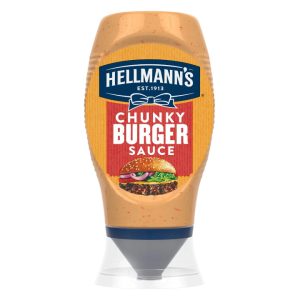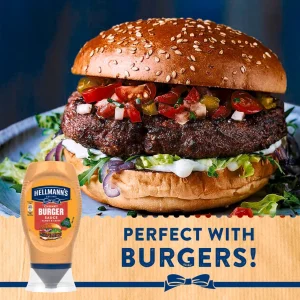Hellmann’s: From a German Immigrant to a Global Mayonnaise Icon
The story of Hellmann’s Mayonnaise begins not in the United States, but in Germany, where a young Richard Hellmann first began cultivating his love for food. Born in 1876 in Vetschau, Germany, Hellmann was working as a food market apprentice by the age of fourteen. Driven by ambition and the pursuit of opportunity, he emigrated to New York City in 1903, a move that would mark the beginning of one of the most iconic food brands in the world.
Not long after arriving in New York, Hellmann met Margaret Vossberg, the daughter of German immigrants who owned a delicatessen. The two shared both a love for food and a drive to succeed. They married in 1904, and in 1913, they opened their own business—Hellmann’s Delicatessen—on Columbus Avenue in Manhattan. Within the deli, Richard began preparing his own version of mayonnaise, using a carefully crafted blend of ingredients to create a rich, creamy texture that customers quickly came to love.
The mayonnaise sold so well at the deli that Hellmann began packaging it in jars and selling it to other local grocers. By 1915, he closed his store to focus entirely on mayonnaise production, opening a small factory on Lawrence Street. Within a year, he was operating out of a larger facility on Steinway Street in Long Island City, Queens. That same year, he incorporated the business as Richard Hellmann, Inc.
Originally, Hellmann sold two versions of his mayonnaise, distinguishing the one he favored by tying a blue ribbon around the jar. Customers overwhelmingly preferred the “ribbon” version, and in 1920, he officially trademarked the name “Blue Ribbon Mayonnaise.” By then, he had become a U.S. citizen and had begun selling his product beyond New York City. His mayonnaise was so beloved that in 1920, it won a comparative taste test conducted by the New York Tribune, who praised it for its quality and rich oil content.
The Hellmann’s brand quickly gained a foothold in homes and restaurants alike, and by the early 1920s, it was the leading mayonnaise on the East Coast. To keep up with growing demand, Hellmann expanded operations with a five-story factory in Long Island City and began exploring opportunities to bring his product to other regions of the country. During a honeymoon trip to San Francisco in 1922, he scouted the West Coast market and even established a presence there.
However, while Hellmann’s dominated the East Coast, a rival company—Best Foods—was making similar strides out West. Best Foods Mayonnaise had built a loyal following in California and the surrounding states. In a move that reshaped the landscape of commercial condiments, Postum Foods (later renamed Best Foods) acquired the Hellmann’s brand in 1927. Recognizing the strength of both brands in their respective territories, Postum decided to maintain the Hellmann’s name east of the Rocky Mountains and continue using the Best Foods name in the West. This unique dual-brand arrangement persists to this day, with Hellmann’s sold in states like New York and Florida, and Best Foods in California and Washington.
By 1931, Hellmann’s Blue Ribbon Mayonnaise had become the best-selling mayonnaise in the United States. Though Richard Hellmann retired after the brand’s sale, his creation only continued to grow in popularity. In the 1950s and 1960s, Hellmann’s expanded internationally, entering markets in Europe, including the United Kingdom, where it would eventually become a staple product with over 50% market share by the 1980s.
Throughout the 20th century, Hellmann’s remained a household name, known for its signature taste and creamy texture. In 1987, it launched two iconic taglines—“Bring out the Hellmann’s” and “Bring out the best”—that would become synonymous with the brand.
In 1997, the parent company CPC International rebranded itself as Bestfoods to focus on packaged food, before being acquired by Unilever in 2000. This acquisition cemented Hellmann’s place in the global market as part of one of the world’s largest consumer goods companies. Under Unilever’s stewardship, Hellmann’s continued to innovate and adapt to changing consumer preferences.
In 2014, Hellmann’s launched a new squeeze bottle, offering a more convenient way for customers to enjoy their favorite condiment. Two years later, in 2016, the brand responded to the growing demand for plant-based options by introducing its Plant Based Dressing & Spread—a vegan-friendly alternative to its traditional mayonnaise, made without eggs or gluten.
By 2019, Hellmann’s was firmly entrenched as a culinary staple in American households. Its flagship product—Hellmann’s Real Mayonnaise—remained the best-selling mayonnaise in the country. That same year, the brand began making strides toward environmental sustainability. In 2020, it transitioned to 100% food-safe PCR (post-consumer resin) plastic packaging, reducing its reliance on virgin plastic and helping to mitigate plastic waste.
Hellmann’s also committed itself to fighting food waste. In 2021, it launched the “Make Taste, Not Waste” campaign in the United States, encouraging consumers to get creative with leftovers and reduce kitchen waste. The following year, it debuted the “Fridge Night” app, offering simple, flexible recipes—dubbed “flexipes”—to help households make the most of their existing groceries.
In 2022, the brand added a bold new offering to its product lineup: Hellmann’s Spicy Mayonnaise. Made with the same real, simple ingredients as the original, this new flavor offered a fiery twist for those looking to add some heat to their sandwiches and burgers.
What started as a modest deli recipe in early 20th-century Manhattan has become a global icon. Today, Hellmann’s products are sold in North and South America, Europe, Asia, and beyond. From its glass jar roots to plant-based innovation and sustainable packaging, Hellmann’s continues to bring out the best in every bite—just as Richard Hellmann envisioned more than a century ago.









